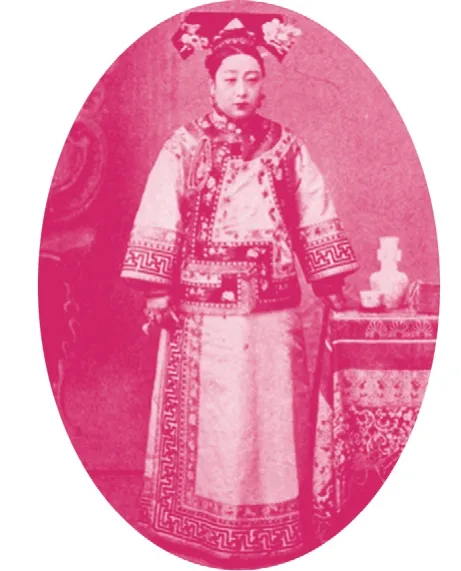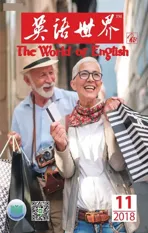In the Mood for Cheongsam1:New Women in Old Shanghai Glamour
2018-11-28By
By
It’s almost sad that whenever we think about the pinnacle2pinnacle顶峰。of modern Chinese style,we always refer to Shanghai in the 1920-30s.As if nothing has happened since.
说起来真有些悲哀。每每思及近代中国的时尚巅峰,我们总会想起上世纪二三十年代的上海,仿佛那之后便是一片沉寂。
[2]It is undeniable that Shanghai in the 1920s and 30s,dubbed by the Chinese as the “Old Shanghai,” epitomized3epitomize概括,集中体现。the most glamorous and most stylish of China in the last century,on par with Paris.You could be a cosmopolitan Parisian or Londoner,but you were simply not chic enough if you had not been to Shanghai.Even Wallis Simpson4通常也称温莎公爵夫人。爱德华八世退位后改称温莎公爵。辛普森是其前夫的姓。,twicedivorced,coarse voiced American for whom King Edward VIII of the United Kingdom and the Dominions abdicated5abdicate退位; 逊位。his throne,had a brief Shanghai sojourn6sojourn短暂停留。(1924)on her cosmopolitan resume.
[2]国人将彼时的上海称为“老上海”,无可否认,它是上世纪中国魅力与时尚的缩影,足可与巴黎媲美。即便身处巴黎或者伦敦这样的世界之都,如果不曾踏足上海,也算不上时尚中人。美国女子沃利斯·辛普森声音沙哑、婚史两段,英国及其属地的国王爱德华八世却甘愿为其放弃王位。纵然是这等人物,1924年也曾到上海小住。
[3]Established in 1843 as a treaty port7根据《南京条约》和《五口通商章程》的规定,上海于1843年11月正式开埠。,Shanghai quickly became the largest international port in China by the early twentieth century,attracting expats and Westerners who called the city “Adventurers’ Paradise.” The aura of “Old Shanghai” was derived from the convergence of the Western influences and Chinese sensitivities: rich art deco8art deco装饰派艺术(流行于 20 世纪 20 至 30 年代,呈几何图形,线条清晰,色彩鲜明)。architecture and designs flaunting an international flair,profusely9profusely极丰富地。illustrated tabloids disseminating the latest trends and celebrity gossips,and beautiful people indulging in their legendary,alas,complicated romances.
[3]上海1843年通商开埠,20世纪初一跃成为中国最大的国际港口,慕名而来的外籍人士和西方人把它称作是“冒险家的乐园”。“老上海”的光影交融着西式的陶染与中式的敏锐:充满装饰派艺术气息的建筑洋溢着国际范儿,层出不穷的画报传播着时尚与轶事,还有那艳丽的佳人啊,沉醉在传奇般纷繁的浪漫故事中。
[4]But nothing embodied the Old Shanghai’s unique allure more than cheongsam.And in the world of global fashion,nothing represents the quintessential “Chinese Element” more than cheongsam,known asqipaoin Mandarin,with many of its primary attributes,such as high collar,side slits and hourglass body-conscious shape being equated with the Eastern mystique.Cheongsam reached its current feminine form in the Old Shanghai.
[4]但要说什么能展现老上海独有的魅力,除了旗袍之外,便再无适合的了。在时尚界,也只有旗袍最能体现“中国元素”的精髓。旗袍的许多主要特质,如高领、侧边开衩及其勾勒出的沙漏型身材,无不幻化出东方的神秘感。富于女性魅力的旗袍款式得以定型,正是在“老上海”时期。
[5]Frankly,I seldom wear cheongsam when there is a Chinese gathering.It’s too predictable.With my dark straight hair and “charming” (as I have been told)accent,I do not need another Chinese Element to exude10exude显露(感觉或品质)。my Chineseness.
[5]说实话,参加中国人的聚会我很少穿旗袍,太老套了。我有一头乌黑的直发,还有一口(据说是)很“迷人”的口音,我的中国特质无须另一中国元素来彰显。
[6]In my prior incarnation as a Wall Street lawyer,one time I attended a cocktail reception at an international conference in Asia.The dress code called for “smart cocktail.” Out of a whim I showed up in a rose red cheongsam made of cotton eyelet11eyelet小孔。fabric that I picked up in Shanghai,leaving all of my (predominantly male)colleagues and clients,who used to see me suited up in pinstripe12pinstripe带有白色细条纹的深色衣料;细条纹西服。black or blue,with their mouths agape in admiration.Wow—I suddenly realized that cheongsam was still a “turn-on” these days!

[6]之前我在华尔街当律师,有次到亚洲参加一场国际会议,会议鸡尾酒会的着装要求是“时髦鸡尾酒礼服”。心血来潮的我,穿了一条购自上海的玫红色网眼棉质旗袍,这让之前看惯我一身黑色或蓝色细纹西装的同事(多为男士)和客户目瞪口呆,赞叹不已。哇哦,我突然意识到,旗袍依然“魅惑十足”。
[7]In effect,for many Chinese ladies,cheongsam was the best way to pull off a professional look without looking macho.Ironically,despite its purported13purported据称的。sexual appeal and association with exotic seductresses in the West,the popularity ofqipaohad something to do with the revolutionary history of the early twentieth century,the birth of “New Women”and related progressive causes.It embodied women’s liberation,intellectual independence and free spirits.In 2010,a popular spy TV series in China titledQIPAOtold a story of a young female student turning into a political assassin during the Japanese invasion of China.Code-named Qipao,she ingratiated14ingratiate使迎合,使讨好。herself with the villain Chinese collaborator who sold himself out to the Japanese military force,taking advantage of his fetishistic15fetishistic迷信的;物恋的。collection of qipao and women who wore them.
[7]实际上,对于很多中国女性而言,旗袍是想要展现职业形象但又不想太过强势的最佳选择。耐人寻味的是,尽管旗袍展现了女性的性感并在西方人看来富有异国风情,但它的流行却与20世纪早期的革命史密不可分,在那段岁月中诞生了“新女性”和她们的进步事业,旗袍更是体现了妇女的解放、思想独立和自由精神。2010年,中国播出了一部名为《旗袍》的热门谍战剧,讲述了日本侵华期间一名年轻女学生从事政治暗杀的故事。代号“旗袍”的她亲近卖国求荣的汉奸,利用的正是汉奸对旗袍和穿旗袍女性的痴迷与崇拜。
[8]Eileen Chang (a.k.a.Zhang Ailing,1920–1995),China’s Virginia Woolf16英国女作家、文学批评家,意识流文学代表人物。and author ofLust,CautionandLove in a Fallen City,among others,staged most of her fiction against the backdrop of Old Shanghai,even in the stories that she wrote after emigration to the United States.According to Chang,a keen observer of the fashion from the era,qipao,or “banner gown” after the eight military banners under which the Manchus had invaded China in the seventeenth century,had always existed alongside Chinese fashions.During the Qing dynasty (1644–1912),the last imperial dynasty of China,women of the Han descent wore two pieces while the Manchu women wore a long robe.With the establishment of unity between the various peoples by the new republic,women all over the country suddenly began to wearqipao—not because they wanted to show their political allegiance to the Manchu Qing dynasty or their support for its restoration,but “because they wanted to look like men.”
[8]张爱玲(1920—1995)被称作“中国的弗吉尼娅·吴尔夫”,写过《色戒》《倾城之恋》等小说,她大部分的作品都以老上海为背景,移民美国之后的小说也是如此。张爱玲当时也热衷时尚,据她考证,旗袍(或称“旗装”)在满洲八旗入主中原之后一直与汉族时装并存。清朝(1644—1912)是中国最后一个朝代,汉族妇女上衣下裙,满族妇女则一袭长袍。民国建立、民族统一之后,全国妇女一夜之间改穿旗袍——这并不是因为她们要向满清表达忠心或是支持复辟,而是“因为她们要与男子平起平坐”。
[9]The earlier version of qipao was wide and loose,concealing the figure of the wearer.With time,however,the qipao was tailored to become more form fitting and revealing.Whether you were a student,socialite,courtesan,movie star,dancing girl,housewife,artist,you walked down the street with your Shanghai attitude.

[9]早期旗袍宽松肥大,遮掩了女性的身材,然而随着时间的推移,旗袍的剪裁变得更为贴身与暴露。无论是学生、名媛、交际花、电影明星、舞女、主妇还是艺术家,穿着旗袍,你都可以在街上走出一种上海的韵味来。
[10]In the early 1920s,qipaowas straight but already more fitted.The waistline was low,in tune with the Art Deco fashion from the 1920s in the West.The history ofqipaoin Shanghai’s fashion statement was inextricably intertwined with the rich fabric of the Western influences such as Hollywood silver screen fashion and Parisian style.And Shanghai’s fantasy in turn inspired many of the new sartorial17vocabulary in the West.
[10]20世纪20年代早期,旗袍虽然还是直身款式,剪裁却已更为贴身。当时旗袍的腰线很低,贴合了20世纪20年代西方的装饰艺术风格。在上海的时尚清单中,旗袍的发展史总是与好莱坞银幕时尚以及巴黎风范这些西式的陶染有着千丝万缕的联系,而梦幻的上海时尚又反过来在西方世界催生出众多的服饰新词。
[11]1930s saw the fertile18interplay between the East and the West,paving the ground for the formation of the classical Shanghai styleqipao,when people began to wear a western overcoat,jacket or sweater over aqipao.During the same period,qipao-making absorbed Western design elements such as turndown collar,V-neck,ruffle collar,ruffle sleeves and slit-sleeves.The introduction of bust darts,waist darts,inset sleeves and shoulder slits19further played up the wearer’s body shape.These all occurred when all aspects of sartorial industries were in full bloom in Shanghai.Thanks to a burgeoning textile industry with a large quantity of products imported from overseas,a wide variety of satin,silk,cotton,woolen cloth and gauze made qipao a modern statement.
[11]30年代开始,东西方之间互动频仍,女性开始在旗袍之外罩上长、短外套或者毛衣,这种穿法成为上海旗袍经典款式的先导。同时,旗袍的制作吸收了西式的设计元素,如翻领、V字领、褶皱领、褶皱袖和开叉袖。胸省、腰省、内袖缝、开肩缝等技艺的引进,进一步展现了女性的身姿。所有这些,都发生在上海制衣行业全面振兴的年代。纺织行业兴起,缎子、丝绸、棉布、羊毛布和薄纱布等各种外国衣料涌进中国,旗袍成了流行时尚。
[12]Simultaneously revealing and concealing,qipaois an understatement about proportion and style.The highly stylized calendar advertisements from the period contained a wealth of pictorial information about the development of the history,painting,industry,products,theater arts and garments.The calendars featured stylish ladies,often inqipaoand accessorized with Western-style fur coats or jewelry,chronicling the evolution history of theqipaostyles.You see these women smoking cigarettes,playing golf,ballroom dancing,putting on make-ups,drinking Coca-Cola,fishing or attending to toiletry20toiletry〈美〉化妆品。.
[12]旗袍的线条若隐若现,淡化了比例和风格。那个年代的年历广告高度程式化,画面蕴含丰富的信息,展示了历史、绘画、工业、产品、戏剧艺术和服饰的发展状况。年历上的时髦女郎身着旗袍,配以西式的毛皮大衣和珠宝首饰,反映了旗袍风格的演变之路。这些女郎,或指尖青烟,或挥杆高球,或舞姿摇曳,或傅粉施朱,或畅饮可乐,或垂杆待鱼,抑或摆弄化妆品。
[13]In the past few seasons,cheongsaminspired Chinese fantasies walked down the runways for Chanel’s pre-fall Paris-Shanghai collection,Ralph Lauren’s Fall/Winter collection,Jason Wu’s Fall/Winter collection,Gucci’s Fall/Winter collection,and Emilio Pucci’s Spring/Summer collection,to name just a few.
[13]在过去几季里,香奈儿早秋“巴黎—上海”系列、拉尔夫·劳伦秋冬系列、吴季刚秋冬系列、古驰秋冬系列以及埃米利奥·璞琪春夏系列的T台上,都行走着旗袍风格的中国幻想。
[14]This eternal return of theqipaoelements in international fashion attests to how the Old Shanghai style remains relevant to our contemporary sensitivity.In today’s Shanghai,you can still walk down the numerousqipaospecialty shops that lined the Changle Road and Maoming South Road and pick out you flight to history with a century-old fantasy.■
[14]国际时尚中旗袍元素的轮回,力证了当今时尚风情中依然保有老上海的风尚。时至今日,你依然可以漫步上海长乐路和茂名南路,在沿街的旗袍店里精挑细选,穿行在梦幻之都的百年时尚当中。□
(译者曾获第五届“《英语世界》杯”翻译大赛优秀奖;译者单位:广西民族大学)
